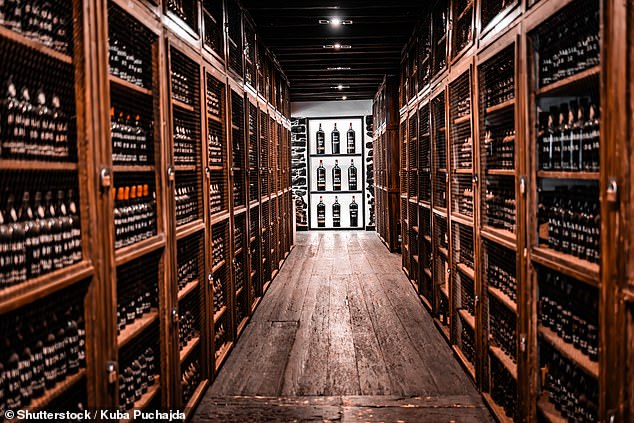[ad_1]
Like most luxury goods markets, investment grade wine has endured a bruising couple of years.
Wine had enjoyed a bumper pandemic, with the combination of lockdown conditions and lower interest rates helping to attract new investors and drive prices to all-time highs.
But the Liv-Ex 1000 – the broadest available index of investment grade wine – has slumped more than 20 per cent from its 2022 peak, marking an unusually large decline in the alternative investment asset’s history.
Analysts point to higher interest rates, subdued demand from key markets like China and, more recently, US trade tariffs.
Given the context in which the decline has taken place, wine’s reputation as an effective hedge against inflation may have taken some damage.
The value of some very wealthy people’s cellars will also have declined significantly, although they will theoretically lose less money if they take the unusual step among fine wine collectors of opening some bottles.
But wine boasts an impressive enough longer-term performance record, as well as lucrative UK tax efficiency credentials, to keep many investors on board.
They will be hoping that prices have finally hit the bottom of the barrel.

Investors in the €30bn fine wine market are searching for signs of life
‘The bottom was expected to come a lot sooner,’ account manager at Moncharm Wine Trader, Matthew Knight, told This is Money.
He said: ‘We had a very unique time [before 2022] when the impact of the pandemic was amplified by certain catalysts like a huge harvest shortage in Burgundy, and there came a point where prices were too high.
‘We’re still waiting for the resurgence in life after the pandemic from China.
‘In the West, there was a significant bounce back in demand in 2022, but it’s been a lot more subdued and muted in the East, so that’s a major value driver that’s been missing.’

The Liv-ex 1000 index is down 20% over the last year two years

No investment grade wine market was safe from the tariff-induced slump
Recent headwinds have been driven by the White House, with wine caught up the in the market chaos that ensued after Donald Trump’s ‘liberation day’ tariffs.
Liv-Ex’s May 2025 market report shows total trade value plummeted 30.2 per cent month-on-month in April in the wake of the announcement, though the market was also impacted by a major trade show in Bordeaux and the timing of the Easter break.
And the online marketplace expects US trade policy to continue to weigh on the asset class as uncertainty persists.
It said: ‘While the 90-day reduction in EU wine tariffs has brought some temporary respite, the situation remains one of severe uncertainty.
‘For instance, it is unclear whether there might be any changes to a goods on the water policy.
‘Given this lack of clarity, it is likely that US buyers will continue to sit tight until 9 July when a further decision can be expected.’
Over the longer term, however, analysts point to the influence of US interest rates.
‘The past five years have taught us some important lessons about the relationship between interest rates and luxury collectable prices,’ former investment banker and co-founder of trading platform Cru World Wine Jeremy Howard wrote late last year.
‘In a nutshell, falling/low interest rates appear to have more power to drive prices upwards than we previously realised.
‘But conversely, rising/high rates can also erase those gains.’
However, he added, ‘value is starting to emerge in a number of areas’.
Interest rates could have a bigger impact on the wine market than previously thought
The fine wine market reached a value of €30billion in 2024, with the Liv-ex Fine Wine 1000 up 300 per cent in the 20 years since its inception.
Analysts at Bain & Company expect the market to be worth €35billion to €40billion by 2030, which would represent a 4 to 6 per cent compound annual growth rate from 2025.
Bain’s most recent Fine Wines and Restaurants Market Monitor report highlights Trump’s tariffs, ‘cautious consumer spending’ and ‘increasing trends toward alcohol moderation by newer generations’ as key factors holding the market back.
‘While the market faces short-term headwinds, its fundamentals remain strong, positioning it as a core component of the luxury landscape for years to come,’ added Federica Levato, leader of the firm’s EMEA fashion and luxury practice.
For Moncharm’s Knight, a key catalyst for an improvement could be the market reception to closely-watched new wine releases.
He says: ‘There is quite a lot of excitement around the potential of what a new En Premeur campaign could bring.
‘The 2024 vintage which was unveiled very recently was priced at about 25 per cent below the previous year.
‘While this may not be enough alone for the vintage or the Bordeaux market to rally, it’s certainly one of the key aspects that we needed to see for people to feel a bit more excitement about buying some wine in the barrel.’

Fine has held up better than other luxury goods markets
DIY INVESTING PLATFORMS

AJ Bell

AJ Bell
Easy investing and ready-made portfolios

Hargreaves Lansdown

Hargreaves Lansdown
Free fund dealing and investment ideas

interactive investor

interactive investor
Flat-fee investing from £4.99 per month

InvestEngine

InvestEngine
Account and trading fee-free ETF investing
Trading 212
Trading 212
Free share dealing and no account fee
Affiliate links: If you take out a product This is Money may earn a commission. These deals are chosen by our editorial team, as we think they are worth highlighting. This does not affect our editorial independence.
[ad_2]
This article was originally published by a www.dailymail.co.uk . Read the Original article here. .



